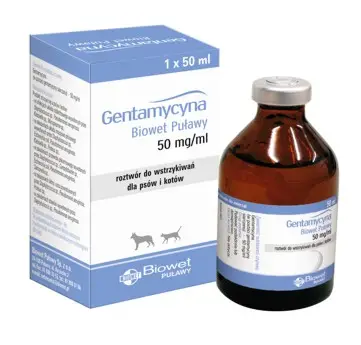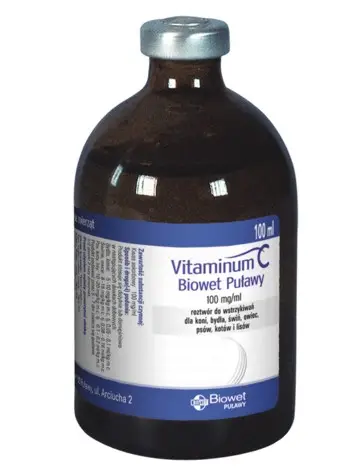Description
Gentamicin solution for injection for dogs and cats, used in treatment of respiratory infections, urogenital infections, dermatitis, joint conditions, otitis, gastrointestinal infections.
Active substance and excipient content
Gentamicin (in the form of gentamicin sulphate) 50 mg/ml
Therapeutic indications
The product is used in dogs and cats:
– infections of the respiratory tract caused by Staphylococcus sp., Pseudomonas aeruginosa, Klebsiella sp., Mycoplasma sp.,
– infections of the urogenital tract caused by Staphylococcus sp., Escherichia coli, Pseudomonas aeruginosa, Klebsiella sp., Proteus sp.,
– gastrointestinal infections caused by Staphylococcus sp., Campylobacter sp., Escherichia coli, Pseudomonas aeruginosa, Salmonella sp.,
– in skin and ear infections caused by Staphylococcus sp., Pseudomonas aeruginosa, Proteus sp.,
– in joint infections caused by Staphylococcus sp., Pseudomonas aeruginosa.
Contraindications
Pregnancy.
Renal insufficiency.
Allergy to aminoglycoside antibiotics.
The drug should not be used in highly dehydrated animals.
Adverse reactions
Long-lasting administration or overdosing of gentamicin may lead to damage to kidneys or the organ of hearing. Intracanal administration may induce inflammation of the nerve roots of the medulla, fever and chronic pleocytosis.
Any adverse reactions emerged after administration of the product or any observed symptoms not listed in the leaflet (including symptoms reported in humans following exposure to the product) should be reported to the competent veterinarian, Marketing Authorization Holder or the Office for Registration of Medicinal Products, Medical Devices and Biocidal Products. The report form should be downloaded from https://www.urpl.gov.pl (Department of Veterinary Medicinal Products).
Posology per target species, routes and methods of administration
Gentamicin is administered subcutaneously or intramuscularly in a dose of 0.8 ml/10 kg b.w. (which corresponds to 4 mg of gentamicin /kg b.w.)
– on the first day of treatment the drug is administered every 12 hours
– next days – once daily every 24 hours.
This antibiotic is generally administered within 4-5 days; in urinary infections 7-10 days. Alkalisation of urine increases the activity of the antibiotic.
Recommendations for proper administration
None.
Withdrawal period
Not applicable.
Special precautions for storage
Keep out of the sight and reach of children.
Store at a temperature below 25°C. Protect from light. Do not freeze.
Use within 28 days after the first opening of the container.
Do not use after the expiry date given on the label.
Special warnings
Special precautions for use in animals:
Young animals, in which the process of renal elimination of gentamicin is slower than in adult animals, are more susceptible to the toxic effect of the drug.
Use half the recommended doses in animals aged up to two weeks.
The product should be used on the basis of results of resistance tests for bacteria isolated from sick animals. If this is impossible, treatment should be performed on the basis of local epidemiological information concerning sensitivity of isolated bacteria. If the condition of an animal requires longer administration of the drug, monitoring the condition of the kidneys is recommended through concentrations control of urea and creatinine in the blood serum.
Special precautions for persons administering the medicinal veterinary product to animals:
The product may have a sensitising effect on the skin causing contact dermatitis. During administration of the drug, protective clothing should be worn and special caution should be exercised. On accidental contact with the drug, the solution should be washed from the skin or the mucous membranes immediately. In the case of a self-injection, a hypersensitivity reaction may occur. After accidental self-injection, immediately seek medical help and show the information leaflet or the package to the physician.
Pregnancy:
Do not use throughout pregnancy.
Lactation:
Due to the nephrotoxic effect, use carefully in lactation only when the benefit for the mother exceeds the potential risk for the newborn animals.
Interaction with other medicinal products and other forms of interaction
Gentamicin displays cross-resistance with other amino glycosides. It has a synergic effect with β-lactam antibiotics (especially ampicillin and benzyl penicillin) on enterococci, staphylococci and streptococci. It also has a synergic effect with vancomycin and rifampicin on streptococci and staphylococci. Cephalosporins and some diuretics intensify nephrotoxicity and ototoxicity of the drug. Therefore, the drug cannot be administered in combination with cephalotin, cephaloridine, etacrynic acid, mannitol and furosemide. Its simultaneous use with vancomycin intensifies nephrotoxicity of both drugs. A combination with cisplatin reduces excretion of gentamicin thus posing a risk of nephrotoxicity and hypomagnaesemia. The preparation should not be mixed with solutions of penicillins with a wide spectrum because it may lead to inactivation of amino glycoside. The simultaneous use with amphotericin B, cyclosporine, cisplatin, methoxyflurane, acyclovir and non-steroid anti-inflammatory drugs may result in renal damage. Gentamicin administered in general anaesthesia in combination with cyclopropane may cause apnoea.
Overdose (symptoms, procedures concerning immediate help and antidotes):
After gentamicin overdose, functional disorders of the kidneys, neuromuscular block, impaired hearing may occur. In such a case, the administration of the drug should be discontinued.
Pharmaceutical incompatibilities:
Do not use with other antibiotics, strong diuretics and potentially nephrotoxic and ototoxic drugs.
Do not combine with anaesthetics or myorelaxants.
Special precautions for the disposal of unused veterinary medicinal product or waste materials derived from the use of such products
Medicines should not be disposed of via wastewater or household waste.
Ask your veterinary surgeon how to dispose of medicines no longer required. These measures should help to protect the environment.
Shelf life
Shelf life for a medicinal veterinary product packaged for sale – three years.
The durability period after the first opening of the immediate container: 28 days.
Other information
For more information about this veterinary medicinal product, contact the Marketing Authorization Holder.
For animal treatment only.
Subject to medical prescription – prescription drug.
Tobe administered under veterinary supervision.
Marketing Authorization Holder:
Biowet Puławy Sp. z o.o.
- Arciucha 2, 24 – 100 Puławy
Tel/fax: (81) 886 33 53, Tel: (81) 888 91 00, e-mail: sekretariat@biowet.pl
2014-04-18 SPC
31.08.2017 r.






